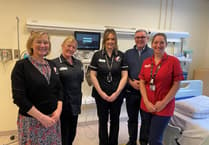According to the British Heart Foundation, figures suggest nearly a third of adults in the UK would be unlikely to attempt CPR if they found someone in cardiac arrest due to lack of knowledge of how to perform the life-saving technique.
This is in spite of it being a ’relatively simple technique to learn’, according to Manx Care.
Paul Ellis, resuscitation officer and head of the team at Noble’s Hospital, explained that he would expect figures would be similar in the island.
He said: ’It’s hard to say for sure it’s the same but it will be similar numbers because we follow what happens in the UK, so we don’t teach CPR in schools.
’It’s teaching CPR in schools which would really start to make a difference.’
Currently, CPR training is not mandatory for primary and secondary students.
However, a number of schools engage with training providers to support the delivery of CPR and first aid to students.
Mr Ellis feels the island is lacking in education and training for CPR, particularly in educational settings.
He continued: ’The government stance is that if schools want to teach it then they can but in the UK, the Resus Council said that got about 20% of children taught CPR.
’They quote Norway as a good example, so Norway has its own curriculum and therefore 99% of children are taught CPR and they have survival as high as seven out of 10 people in the community, whereas in the UK it’s less than one in 10.
’I’ve been pushing this at work because if all my colleagues are singing from the same hymn sheet that’s maybe 2,000 people on the Isle of Man saying "wow, why are we not teaching it in schools?"’
Mr Ellis stressed that training should be completed every school year.
The resus team lead said: ’It should be really once every year and I would probably go as far as saying, if they could I’d try and do it more often than that, so maybe at the start and end of each school year.
’It’s a well-known fact that with the kind of training required if you don’t use the skills you learn, you will lose them in as little as three months.
’It’s not that you don’t know what to do, it’s the confidence. If you’re not doing it regularly, you’ll lose the confidence in what you have to do.
’We see that in the hospital all the time because we don’t treat a lot of cardiac arrests anymore, it used to be we might have 100 a year but now we’re down in the 20s some years.’
His view is similar for the workplace.
Mr Ellis added: ’In the workplace ideally you want employers offering their employees the opportunity to do CPR.
’All employers are supposed to have first aiders but the more people that can do it, the better the chance that someone will have a go and you’ll see survival.’
Since the Covid-19 pandemic began, additional guidelines for CPR have been put in place.
In the community, it is discouraged to attempt to ’give breath’ on strangers but if it’s a family member or loved one then it can be done.
’For people you don’t know, the Resus Council recommends that you should place an item of clothing or something over the nose and mouth to help prevent any sort of aerosols escaping when you do CPR,’ said Mr Ellis.
Giving breath is no longer fully encouraged as part of the guidelines and hasn’t been since 2005. If a person doesn’t wish to give breath, they don’t have to when performing on a stranger.
The CPR guidelines are reviewed every five years by an international committee which is how changes can occur.
In 2005, there were some major changes, including giving breath and increased compressions, but since then there have only been minor changes.
When asked if there were any common mistakes Mr Ellis had noticed people make, he said: ’Often the speed of compressions is something people get wrong because you have to guess how hard to press and how fast to go.
’Human beings are not very good at guessing things, so from a training point of view we tell people just to press as hard as they can.
’You’re trying to achieve a depth of between five and no more than six centimetres which is quite a deep compression depth.
’Speed is probably the trickiest thing but the message has got to be it’s better to do something than nothing, so give it a go.’
Following a huge rollout of defibrillators by Craig’s Heartstrong Foundation which has seen more than 500 defibrillators installed around the island, Mr Ellis was concerned the public didn’t know the location of their closest defibrillator.
He said: ’I think without someone out in the community teaching, my concern would be that people don’t really know what those defibs are for.
’Last year when we were in Ramsey Town Hall we asked everyone, "do you know where your closest public access defib is?" and there’s one on the building and at least half of them didn’t know there was one.’
Mr Ellis continued: ’In the UK in the early 2000s, the UK Government instigated a public access defib programme where they spent something like £120 million initially on public access defibrillation.
’Included in those costs were people who could offer training to the general public and they were employed into ambulance services, they were called community defib officers, and they would go around the community giving sessions to raise awareness of the public access defib.
’Now, in the Isle of Man we’ve got a small charity led public access programme but they can’t employ someone into the community because it would be costly.
’That’s where we’re falling down. That’s something that should be looked into in my opinion.’
More information on CPR and how to perform it can be found on www.resus.org.uk.
How to perform CPR
To perform CPR, it’s advised by Resuscitation Council UK that, after getting help, you:
l Start chest compressions as soon as possible.
l Deliver compressions on the lower half of the sternum (in the centre of the chest).
l Compress to a depth of at least 5cm but not more than 6cm.
l Compress the chest at a rate of 100-120 per minute with as few interruptions as possible.
l Allow the chest to recoil completely after each compression; do not lean on the chest.
l Perform chest compressions on a firm surface whenever feasible.
l Continue CPR until an AED (or other type of defibrillator) arrives on site and is switched on and attached to the person.
l Do not delay defibrillation to provide additional CPR once the defibrillator is ready.




